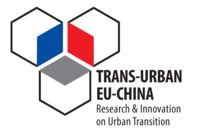
TRANS-URBAN-EU-CHINA
Transition towards urban sustainability through socially integrative cities in the EU and in China
DIGITAL PLANNING TOOL
1. Purpose(s)
Digital applications are used to better manage the increasing urban complexity. Digital planning tools support different aspects of spatial planning, such as problem diagnosis, data collection, data mining and extraction, spatial and temporal analysis, data modelling and visualization.
Key Words: digital; planning tool; urban complexity
2. Relevance and Impact
Due to the increasing complexities of planning processes, the heterogeneous context and the variety of overlapping trends, digital tools can support decision making processes with information derived from real-time data.
The tool as such was not tested on a large scale in the project as planned because of COVID-19. The tool was presented as an approach in the online workshop in August 2020 and examples were shared with Chinese partners.
In the case study cities, digital planning tools were used as a tool in the cities of Santander, Beijing and Shenzhen. In Chinese cities the application of big data technology in urban and rural planning has become a research hotspot in research and practice in Chinese cities. In digital planning tools the chance is seen to fully consider the needs of enterprises and residents with the help of technologies, and directly serve all those actors of the city in a problem-oriented way. Chinese stakeholders see the main benefits of digital planning in:
- Taking big data integration as an opportunity to break through inter-department barriers as well as establish a collaborative system for Smart City planning
- Quantitative analysis of city dynamics and even forecasting, mainly based on big data conducted to optimize the spatial layouts of industry, transportation infrastructure and public services
- Use big data to fully excavate and integrate with the city’s core resources and carry out characteristic design.
- Use big data as support to comprehensively explore and analyse data concerning urban residents, enterprises as well as the government, so as to propose innovative opinions on mechanisms and systems that are conducive to improving administrative efficiency.
3. Strenghts
Tools can integrate real-time data, use big data as support to comprehensively explore and analyze information concerning urban residents and enterprises.
4. Weaknesses
The risk of placing too strong an emphasis on technologies that are disconnected form the human needs. Digital planning tools may fail to provide a real added value and thus turn into a ‘nice to have’ implementation. The complexity, structure and user friendliness of digital planning tools will determine whether these will be applied.
5. Good practice examples
Santander Smart City Platform (ES)
The Santander Smart City (map) platform integrates heterogeneous data derived from all municipal services. This platform provides a flexible and agile environment capable to create, facilitate and store a common repository of information. The ownership of the database has been agreed in a jointly signed agreement between the municipality of Santander and the University. The data platform is set-up to allow for data sharing (real time data, such as traffic, parking sensors, street lights etc.) as well as statistical data. The set up of a data market place and the deployment of different services and apps has been prioritized from the beginning of the Smart Santander development process.
Beijing (map) CITYIF: Cloud platform for planning
Created by the team of Beijing Planning and Design Institute, CITYIF consists of three types of sub-platforms, those being; data platform, smart platform (self-organizing group of planners) and implementation platform (bottom-up community governance force). CITYIF functions mainly in the following aspects: i) Technical processing and integration of basic re-sources through quantitative urban research, geographic information systems, data visualization, etc.; ii) Public display and dissemination based on online/offline tools (such as websites, Weibo, WeChat and exhibitions); iii) Provide application services for different user groups (through the government interface, planner interface and citizen interface).
Shenzhen (map) Intelligent-Twins for urban safeguard system by Huawei
Shenzhen Intelligent-Twins is a typical practice of "Urban Intelligent Twins" vision that was initially proposed as well as applied in Smart City construction of Shenzhen by Huawei. The connotation of urban intelligence is to treat the city as a life organism that can think, perceive and evolve. Technologies of 5G, cloud computing and AI are adopted to promote data sharing and business collaboration among government departments, thereby breaking institutional barriers and constructing an urban safeguard system that can provide services for various scenarios such as urban governance, disaster prevention, emergency rescue, and epidemic prevention. Highlights of the system are listed as follows: i) the ‘trunk’ and ‘nerves’, that is, the real-time perception and intelligent interaction of urban space; ii) the ‘brain’, that is, the urban intelligence operation center (IOC) serving city managers, characterized by its ‘self-awareness’ and co-command functions; iii) cross-domain applications of data, that is, to break ‘data islands’ through integrated applications based on scenarios. In general, the construction of Urban Intelligence Twins provides a solid technical foundation for refined urban management in the future.
6. References
7. Author(s) of the article
Gudrun Heindlmaier
